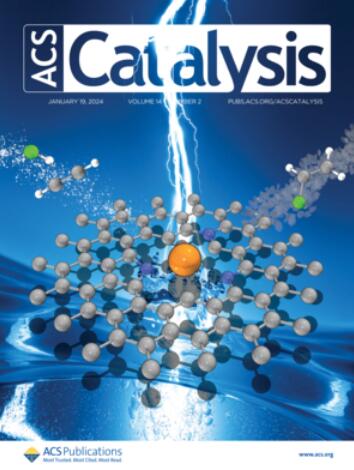一锅双酶生物催化氧化系统的气液界面效应
IF 11.3
1区 化学
Q1 CHEMISTRY, PHYSICAL
引用次数: 0
摘要
生物催化氧化为化学生产提供了一个潜在的高效平台,但在这种反应中形成的气液界面经常影响生物催化剂的性能。在这里,我们报告了乙醇脱氢酶(ADH)、NADH氧化酶(NOX)和相关辅助因子在暴露于不同气液界面时的动力学稳定性。空气和氧气分别起泡以区分它们的作用。观察到的酶从溶液中损失和活性主要归因于酶通过气液界面、起泡和聚集去除。具有增强亚基之间相互作用的工程ADH显示出更长的半衰期和更好的界面动力学稳定性。同时,还测试了四种不同的NOX酶,得到了不同的稳定性曲线。这项研究显示了为氧依赖性生物催化过程选择合适的酶的重要性,并进一步强调了相关的工艺设备和条件对后续规模扩大测试生物催化剂的重要性。本文章由计算机程序翻译,如有差异,请以英文原文为准。

Gas–Liquid Interface Effects on a One-Pot Two-Enzyme Biocatalytic Oxidation Systems
Biocatalytic oxidation provides a potentially efficient platform for chemical production, but the air–liquid interface formed in such reactions often affects the biocatalyst performance. Here, we report the kinetic stability of alcohol dehydrogenase (ADH), NADH oxidase (NOX), and associated cofactors upon exposure to various gas–liquid interfaces in a defined interface apparatus. Air and oxygen were bubbled individually to distinguish their effects. The observed loss of enzyme from the solution and the activity were mostly attributed to the enzyme removal via the gas–liquid interface, foaming, and aggregation. An engineered ADH with enhanced interactions between subunits showed a longer half-life and improved kinetic stability at interfaces. Meanwhile, four different NOX enzymes were also tested, resulting in different stability profiles. This study shows the importance of selecting the appropriate enzymes for oxygen-dependent biocatalytic processes and further highlights the importance of the relevant process equipment and conditions to test biocatalysts for subsequent scale-up.
求助全文
通过发布文献求助,成功后即可免费获取论文全文。
去求助
来源期刊

ACS Catalysis
CHEMISTRY, PHYSICAL-
CiteScore
20.80
自引率
6.20%
发文量
1253
审稿时长
1.5 months
期刊介绍:
ACS Catalysis is an esteemed journal that publishes original research in the fields of heterogeneous catalysis, molecular catalysis, and biocatalysis. It offers broad coverage across diverse areas such as life sciences, organometallics and synthesis, photochemistry and electrochemistry, drug discovery and synthesis, materials science, environmental protection, polymer discovery and synthesis, and energy and fuels.
The scope of the journal is to showcase innovative work in various aspects of catalysis. This includes new reactions and novel synthetic approaches utilizing known catalysts, the discovery or modification of new catalysts, elucidation of catalytic mechanisms through cutting-edge investigations, practical enhancements of existing processes, as well as conceptual advances in the field. Contributions to ACS Catalysis can encompass both experimental and theoretical research focused on catalytic molecules, macromolecules, and materials that exhibit catalytic turnover.
 求助内容:
求助内容: 应助结果提醒方式:
应助结果提醒方式:


